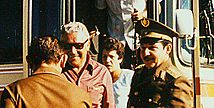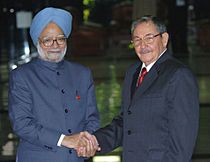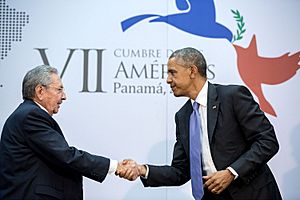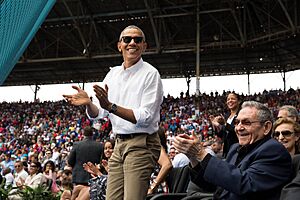Raúl Castro facts for kids
Quick facts for kids
Raúl Castro
|
|
|---|---|
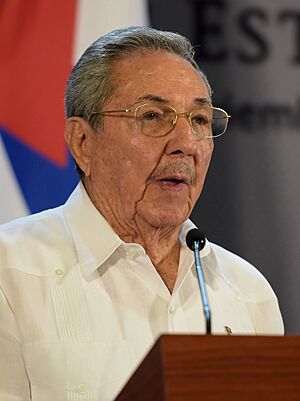
Castro in 2015
|
|
| First Secretary of the Communist Party of Cuba | |
| In office 19 April 2011 – 19 April 2021 |
|
| President | Himself Miguel Díaz-Canel |
| Prime Minister | Manuel Marrero (2019–2021) |
| Deputy | José Ramón Machado |
| Preceded by | Fidel Castro |
| Succeeded by | Miguel Díaz-Canel |
| 16th President of the Council of State and Ministers of Cuba | |
| In office 24 February 2008 – 19 April 2018 Acting: 31 July 2006 – 24 February 2008 |
|
| Vice President | José Ramón Machado Miguel Díaz-Canel |
| Preceded by | Fidel Castro |
| Succeeded by | Miguel Díaz-Canel |
| Second Secretary of the Communist Party of Cuba |
|
| In office 3 October 1965 – 19 April 2011 |
|
| First secretary | Fidel Castro |
| Preceded by | Position established |
| Succeeded by | José Ramón Machado |
| First Vice President of Cuba | |
| In office 2 December 1976 – 24 February 2008 |
|
| President | Fidel Castro |
| Preceded by | Position established |
| Succeeded by | José Ramón Machado |
| Minister of Defence | |
| In office 16 February 1959 – 24 February 2008 |
|
| Prime Minister | Fidel Castro |
| Preceded by | Position established |
| Succeeded by | Julio Casas Regueiro |
| Secretary-General of the Non-Aligned Movement |
|
| In office 16 September 2006 – 16 July 2009 Acting: 16 September 2006 – 24 February 2008 |
|
| Preceded by | Fidel Castro |
| Succeeded by | Hosni Mubarak |
| President pro tempore of CELAC | |
| In office 28 January 2013 – 28 January 2014 |
|
| Preceded by | Sebastián Piñera |
| Succeeded by | Laura Chinchilla |
| Personal details | |
| Born |
Raúl Modesto Castro Ruz
3 June 1931 Birán, Cuba |
| Political party | 26th of July Movement (1953–1965) Communist Party (1965–present) |
| Spouse |
Vilma Espín
(m. 1959; died 2007) |
| Children | 4, including Mariela and Alejandro |
| Parents | Lina Ruz (mother) Ángel Castro y Argiz (father) |
| Relatives | Fidel Castro (brother) Ramón Castro Ruz (brother) Juanita Castro (sister) |
| Signature | |
| Military service | |
| Allegiance | Republic of Cuba |
| Branch/service | Revolutionary Armed Forces |
| Years of service | 1953–1959 |
| Rank | Comandante en Jefe (as President) General de Ejército |
| Battles/wars | Attack on the Moncada Barracks Cuban Revolution Bay of Pigs Invasion Cuban Missile Crisis |
| Awards | Hero of the Republic of Cuba Order of Prince Yaroslav the Wise National Order of Mali Order Prince Daniel of Good Faith First Degree |
Raúl Modesto Castro Ruz (born June 3, 1931) is a Cuban politician and general who was a central figure in Cuba for over 60 years. He was the President of Cuba from 2008 to 2018 and the leader of the Communist Party of Cuba from 2011 to 2021. He took over these roles from his older brother, Fidel Castro.
Raúl was a military leader during the Cuban Revolution in the 1950s. After the revolution succeeded, he became the head of Cuba's armed forces for almost 50 years, from 1959 to 2008. This made him the longest-serving minister of the armed forces in the world.
When his brother Fidel became ill in 2006, Raúl temporarily took over his duties. He officially became president in 2008. He stepped down as president in 2018 but remained the head of the Communist Party, which made him the most powerful person in Cuba. He retired from this last position in 2021, handing over leadership to Miguel Díaz-Canel.
Contents
Early Life and Family
Raúl Castro was born in Birán, Cuba. His father, Ángel Castro, was an immigrant from Spain, and his mother, Lina Ruz, was born in Cuba. Raúl was the youngest of three brothers, including Ramón and the famous Fidel Castro. He also had four sisters and five half-siblings.
As a child, Raúl and his brothers were known for being energetic and were even expelled from their first school. He later studied Public Administration at the University of Havana. Unlike his brother Fidel, who was a top student, Raúl's grades were average.
During his university years, Raúl became a committed socialist. He and his brother became involved in student protests, which were sometimes violent. In 1953, he took part in an attack on the Moncada army barracks, an event that started the Cuban Revolution. For this, he was sentenced to 13 years in prison but was released after 22 months.
Role in the Cuban Revolution
After being released from prison, Raúl and Fidel went to Mexico. There, they planned their return to Cuba to overthrow the government. They sailed to Cuba on a boat named Granma. The landing did not go as planned, and government soldiers attacked them. Only 12 of the 82 fighters, including Raúl, escaped to the Sierra Maestra mountains.
These survivors formed the beginning of the rebel army. Because he was Fidel's trusted brother and a capable leader, Raúl was given important commands. In 1958, he was made a comandante (commander) and led a group of fighters to open a new battlefront in the eastern part of Cuba.
While in control of this area, his forces set up hospitals and schools. In June 1958, his rebels captured several American and Canadian citizens to get worldwide attention for their cause and to stop the government from bombing their positions. The hostages were treated well and released in small groups.
By the end of 1958, the Castro brothers' army had grown to about 2,000 fighters. On January 1, 1959, the Cuban president, Fulgencio Batista, fled the country. The war was over, and Fidel Castro's forces took control of Cuba. After the revolution, Raúl was put in charge of holding trials for soldiers of the old government who were accused of war crimes.
A Long Career in Politics
For decades, Raúl Castro was one of the most powerful people in Cuba's government, second only to his brother Fidel. He was the Second Secretary of the Communist Party of Cuba from 1965 and the First Vice President from 1976. He was also the Minister of the Armed Forces, a job he held for 49 years.
Becoming President of Cuba
In July 2006, Fidel Castro had to have emergency surgery. He temporarily transferred all his powers to Raúl. For the next year and a half, Raúl served as the acting president.
On February 24, 2008, Cuba's National Assembly officially elected Raúl as the new President. Many people wondered if he would rule differently than his brother. Raúl soon began to make changes, especially to the economy.
His government lifted bans on buying items like computers and DVD players. He also allowed private farmers to lease unused government land to grow more food. In 2013, he was elected for a second five-year term and announced it would be his last.
Improving Relations with the United States
For most of his life, Cuba and the United States had a very poor relationship. However, under Raúl Castro's leadership, things began to change. In 2008, he said that good relations would be good for both countries.
A major step happened in December 2014, when Castro and U.S. President Barack Obama announced they would work to normalize relations. Pope Francis helped arrange secret talks between the two governments. In July 2015, Cuba and the U.S. reopened their embassies in Washington, D.C., and Havana for the first time since 1961.
In March 2016, Barack Obama became the first sitting U.S. president to visit Cuba in 88 years. He met with Castro, and they even attended a baseball game together. However, relations became more difficult again under the next U.S. president, Donald Trump.
Retirement from Power
Raúl Castro stepped down as president on April 19, 2018, and was succeeded by Miguel Díaz-Canel. However, he remained the First Secretary of the Communist Party, which meant he was still seen as the country's true leader.
On April 16, 2021, at the Eighth Congress of the Communist Party, Castro announced he was retiring from politics. Three days later, Miguel Díaz-Canel was elected to replace him, marking the end of the Castro family's direct leadership of Cuba, which had lasted for over 60 years. Even in retirement, Raúl Castro is still considered an influential figure in Cuba.
Personal Life
In 1959, Raúl married Vilma Espín, who became a powerful figure in her own right as the president of the Cuban Federation of Women. They were married for 48 years until her death in 2007. They had four children: one son, Alejandro, and three daughters, Déborah, Mariela, and Nilsa.
Their son, Alejandro Castro Espín, is a high-ranking official in Cuba's Ministry of the Interior. Their daughter, Mariela Castro, is a well-known activist and the director of the Cuban National Center for Sex Education.
Raúl Castro was known for being more private and less charismatic than his brother Fidel. He once said, "I have always been discreet, that is my way." After meeting Pope Francis in 2015, he said he was so impressed that he might consider returning to the Catholic Church.
Honours and Awards
Raúl Castro has received many awards from Cuba and other countries. Some of the most important include:
 Cuba Hero of the Republic of Cuba
Cuba Hero of the Republic of Cuba Soviet Union Order of Lenin
Soviet Union Order of Lenin Russia Order of Friendship
Russia Order of Friendship Venezuela Grand Cordon of the Order of the Liberator
Venezuela Grand Cordon of the Order of the Liberator Vietnam Gold Star Order
Vietnam Gold Star Order
See also
 In Spanish: Raúl Castro para niños
In Spanish: Raúl Castro para niños



